#1911 census
Explore tagged Tumblr posts
Text
other names that sound normal now but are actually From Pop Culture- meaning they were used for fictional characters before they became real-people names -include:
- Mavis (from the book The Sorrows of Satan, 1895)
- Pamela (from the book The Countess of Pembroke’s Arcadia, late 16th century, but popularized by the 1740 novel Pamela)
- Imogen (from Shakespeare’s play Cymbeline, c. 1611. possibly a typesetting error on the earlier name Innogen)
- Enola (from the book Enola, or Her Fatal Mistake, 1886)
- Vanessa (from the poem Cadenus and Vanessa, 1812)
- Cedric (from the book Ivanhoe, 1819. transposition of letters from the earlier Saxon name Cerdic)
- Dorian (from the book The Picture of Dorian Gray, 1891. similar masculine names had previously existed, like Dorus, Doros, and Dorios, but Wilde is believed to have coined this specific usage)
- Jessica (from Shakespeare’s play The Merchant of Venice, c. 1596-7. Possibly an Anglicization- Italianization? -of the Hebrew name Yiskah, since the character is Jewish)
fun fact there were at least two people named lancelot recorded in the 1292 paris census so I think we know what the 13th century equivalent of naming your kid sasuke was
#there is also a nonzero chance that the author of the Enola book literally just got the name by spelling 'alone' backwards#as she remarks upon What A Sad Coincidence That Is For The Heroine in the text#also once I saw a census from like 1911 of a Holmes family with young sons named Sherlock and Mycroft#nice
38K notes
·
View notes
Text
you know, the Horrible Histories "Victorian names were WEIRD!!!!" skit leaves out some important info on some of the names (assisted by Ancestry.com searches):
Lettice Berger: "Lettice" was an anglicization of the Roman name "Leticia." Berger is just a normal German surname. Yes, they had the word "lettuce," and I'm sure the similarities occurred to them. But nobody named their child "lettuce" like the vegetable.
O.K. Johnson: Probably just the kid's initials. "O.K." as a slang term was invented in 1830s Boston, but without any evidence of when little O.K. lived (they don't cite any sourced for these names, how convenient), it's impossible to tell whether it would have crossed the pond by the time he was born.
Never [they pronounce the surname Rookrook]: I found a LOT of Nevers in the UK with Indian surnames. So uh. There's that. And a lot of census records online seem to have notes written by the census-taker mislabeled as names- "never opens door" was one I noticed. Just saying. I also found multiple "NEVA Rook" census entries- which probably would have been pronounced "NEE-vah" but sounds like "Never" with a British accent if you tilt your head and squint.
Toilet: Surprisingly common modern misreading of "Violet" on 19th-century censuses with bad handwriting.
Baboon: Found one census where it's a misreading of "Barbara;" others were non-Anglo names like Baban, Babyon, Babboni, etc.
Susan Semolina-Thrower: That's just two unfortuate surnames, I'm guessing? I can't find their sources, again, but I do find a lot of records of "Semolina" as a surname in the UK during the 19th century. The poor parents had no control over that, did they?
Happy: ...yeah, it's a virtue name. And? How is that weirder than Faith, Hope, Grace, Patience, Prudence, etc?
Evil: Another census misreading- usually "Evie."
Minty Badger: "Minty" is short for Araminta/Aminta/Arminta. Still sounds like a Discworld character, but nothing would sound normal with "Badger" as a surname. Araminta Badger at least makes more sense to modern ears, though.
Freezer Breezer: Breezer was a real surname, and parents can be cruel. I don't doubt that- my dad went to school with an "Emily Memily." that being said...I did find a "Fred R. Breezer" born in 1873 in England; see above re: census misreadings. Just throwing that out there. I found it as a corruption/misspelling of "Fraser/Frasier" too.
Scary Looker: I actually found this one. It was a misreading of "Jeany" on a census- the girl's name was Jane Looker, born 1841 in Lancashire to John and Elizabeth Looker. Nice research there, team.
Farting Clack: Fasting Clack or Clark, born 1863 in London. Another lovely misreading from the census. True "Fasting Clark" is not NOT a weird name, but it's a lot less horrible than "Farting Clack" and it makes sense under the Hyper-Christian Parents category.
Princess Cheese was real, not a nickname, and not a misreading or misspelling. Princess May Cheese was born in 1896 in West Bromwich. She married one John T. Brookes in 1914- possibly eager to no longer be a Cheese?
Multiple people really have been christened Bovril, most notably one Bovril Simpson, married in West Ham in 1911.
Incredibly, Raspberry/Rasberry/Roseberry is a real given name, and Lemon a real surname. Most people named Raspberry seem to have been men.
So that's only three of their Wacky Victorian Names that are actually 100% real. Nice job, there, team. I love Ghosts, but get your collective act together!
(They did once have a skit insisting that Victorians called trousers "the southern necessity" when that's actually a phrase from the writings of famously terrible 19th-century author Amanda McKittrick Ros, whose work her contemporaries loved poking fun at. So I shouldn't be surprised)
520 notes
·
View notes
Text
I realized something rather unsettling about E.M. Forster’s Maurice: it would’ve never happened at all—in fact it was so close to never having been written.
Why? Because the novel is a direct result of Forster's visit to Edward Carpenter and George Merril in 1913—specifically, a direct result of a Merril’s touch on Forster’s backside, but broadly of Carpenter’s philosophy and the life he had with his lover, the lower-class Merrill. But here’s the thing: Edward Carpenter and George Merril were almost charged, arrested, and/or imprisoned because of their sexuality and relationship.

Having published his controversial The Intermediate Sex which sought to justify homosexual love, Edward Carpenter came under fire and faced a large public reaction. Someone named D O’Brien, a member of a right-wing group instigated his own large-scale campaign against Carpenter. He printed out pamphlets and wrote letters accusing Carpenter, even sent them to the Home Office and the police who then started investigating Carpenter. The authorities evaluated Carpenter’s published books on homosexuality to determine merits of persecuting him.
However, the Director of Public Persecution at the time, Charles, decided not to open any legal proceeding. Because with the shadow of Oscar Wilde’s infamous trial still palpably felt in the society, he did not want to stir any public discussion about sex or homosexuality through Carpenter or his books. As such, no proceeding against Carpenter happened, and his books were not banned. This ended in 1909.
But the investigation did not stop there. The Derbyshire police was concerned with—and anxious about—getting a case against Carpenter and Merrill as two homosexuals. I think that since Carpenter was upper-class and had a solid reputation, the police went after Merrill instead, especially because O’Brien’s letters mentioned names of several people who knew about Merrill’s "indecencies". But these people were of no avail. Hence, no incriminating evidence was found against Carpenter “beyond strong suspicion”, and before 1911, the whole thing was thus, finally, dropped.
And Forster’s visit to the two men living together in Millthorpe happened in 1913.
(Below: a 1911 census showing Edward Carpenter, the head of house, living together with George Merrill, the housekeeper)
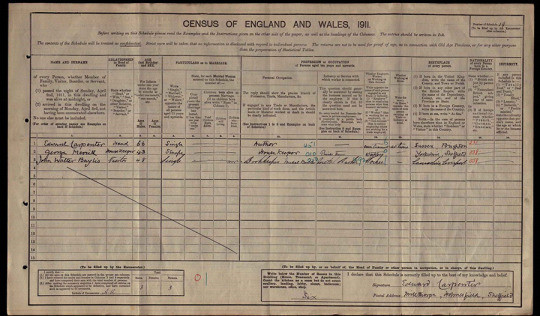
Imagine: had Carpenter and Merril been caught—and imprisonment was most certain for Merril due to his lower station—they wouldn’t have been together at where they were in 1913. Forster probably wouldn’t have visited Carpenter at their cottage at all, and thus, Maurice and its happy ending would’ve never been formed. The lives of the real life Maurice Hall and Alec Scudder could’ve been destroyed before their fictional counterparts had been conceived—and Forster would’ve never seen the happy gay couple he knew to write a gay romance novel with a happy ending.
(Forster could’ve written and even published another version of Maurice—albeit one with tragic ending and deaths of gay characters.)
I used to think Carpenter and Merrill evaded the laws and got through it all because they were smart and brave and discreet, but now I know they were also incredibly lucky, in the sense that it’s almost like Carpenter and Merrill were destined by some higher power to be together and live in an Edwardian gay fairy tale of happily ever after; they were meant to survive as outlaws and to welcome Forster into their home and inspire him to write a gay novel with a happy ending. “Fate has mated it perfectly,” might I quote from Forster himself.
(Below: a 1921 census showing Carpenter and Merrill living together still)

Probably in an alternate universe, Carpenter and Merrill were indeed arrested. Merrill went to prison and suffered the same as Wilde did; Carpenter however was let off due to his status (just like Forster had imagined for Maurice and Alec in real life his terminal notes). I don't want to wonder or ponder too much on that because for now, I'm just glad that I live in this timeline where a homosexual happy ending indeed happened in real life as well as in fiction, in the most impossible times.
Source: https://blog.nationalarchives.gov.uk/edward-carpenter-free-love-advocate-and-lgbtq-rights-pioneer/
#maurice 1987#maurice em forster#maurice#maurice hall#alec scudder#clive durham#em forster#oscar wilde#gay love#happy ending#edward carpenter#George Merrill#gay men#lgbt love#1900s#edwardian#edwardian era#england#lgbt rights#gay books#gay novel
549 notes
·
View notes
Text

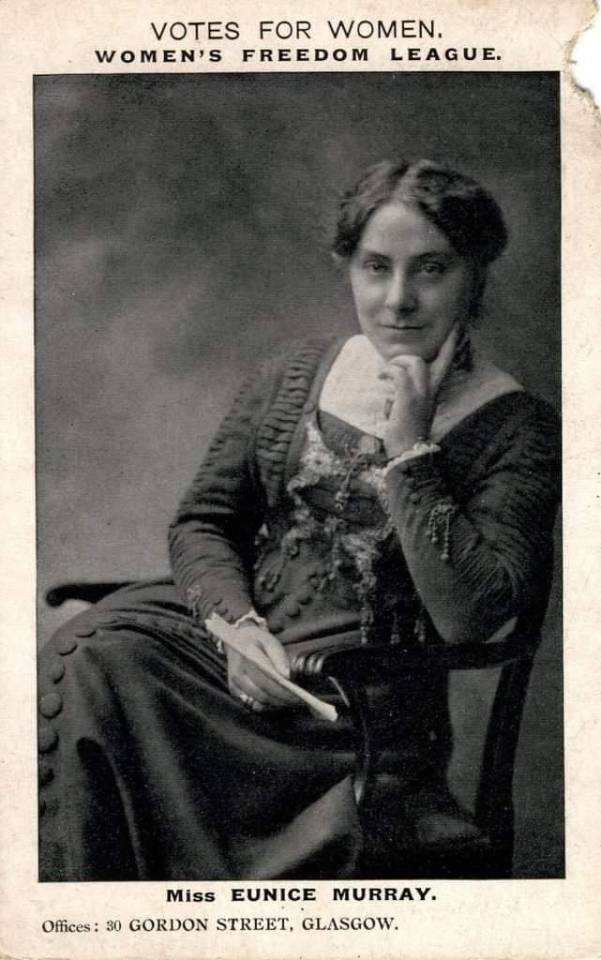

Eunice Guthrie Murray was born on 21st January 1878 in Cardross.
Eunice Murray was the daughter of a well-known Glasgow lawyer, Dr David Murray and Frances Porter Murray, Murray was one of the founders of the Glasgow Ladies Higher Education Society in 1876, both her parents were both supporters of the women's movement, her mother, Frances was born in New York, and raised in Scotland, was a suffragette. Frances’s parents both of whom were active abolitionists, emigrated to Glasgow in 1844.
Murray attended the progressive St Leonard School in St Andrews, where she became involved in philanthropic activities. She was active in the local branch of the League of Pity, volunteered regularly at a local settlement, and was an advocate for temperance. On 9th November 1896 she recorded reading about the formation of the National Union of Women’s Suffrage Societies, commenting
‘I should like to join such a society for the question of the emancipation of my sex is a stirring one and leads to vital matters’.
Given her background it is hardly surprising that along with her mother and her sister, Sylvia Murray, she joined the Women’s Freedom League. The WFL had a strong presence in Scotland, and from 1909 onwards Murray was the secretary for ‘scattered members’—all those who did not live in Edinburgh, Glasgow, or Dundee. Eunice was one of the three Scottish members on the WFL’s national executive committee and in 1913 was described as president for Scotland of the WFL.
The Women’s Freedom League was a non-violent militant group most famous for first chaining themselves to railings and leading the 1911 Census boycott. Inspired after attended the International Women’s Suffrage Alliance in Budapest in 1913, Eunice Murray was arrested for obstruction when she tried to address a meeting near 10 Downing Street on women’s suffrage.
Unlike the Pankhursts’ Women’s Social and Political Union (WSPU) and the National Union of Women’s Suffrage Societies (NUWSS), the WFL continued to campaign for the women’s suffrage throughout the First World War. Murray was an active feminist who had published numerous leaflets on women and their position in society such as The Illogical Woman. Like many feminists, Murray argued for the vote based on the unique roles of men and women. She observed, ‘We have always held, and hold now, that it is because men and women are so different, and not because they are so alike, that we require the vote.
In 1918, women in Britain finally won their right to vote and stand in general elections, if they were over 30 and met minimum property qualifications, and Eunice was quick to take advantage of this major breakthrough and stood as a candidate in Glasgow, Bridgeton in the 1918 election, the only Scottish woman in the first election open to women in 1918, she was unsuccessful, coming third. The results being Coalition Liberal Alexander MacCallum Scott 10,887, Labour James Maxton 7,860 and Independent Eunice Murray 991.
The election was held in the midst of the Spanish Flu epidemic with 327 deaths in the Glasgow that week, compared to 386 the previous week. Schools and docks were closed when half a million Glaswegians took to the polls, of which just over one-third were newly enfranchised women. In response to a claim that all women candidates were pacifists she wrote to the Spectator on 23rd November 1918, ‘I believe that the war we have just fought and won was a righteous one, and that it was the duty of newly enfranchised women to support the country’.
The election saw the defeat of the Asquith Liberals and the landslide of the Coalition Liberals. Murray was not deterred by her defeat and went to on to have an active political life. Elected as councillor in 1923 to Dunbartonshire Council, Murray was also the founder and President of the Scottish Women’s Rural Institute in the area.
Eunice Murray died on 26th March 1960 having led an active and inspirational life and today we remember her as the first women to break the barrier in Scotland to stand as an MP.
12 notes
·
View notes
Text

Rovinj, Croatia. © krktouristinfo
From 1283 to 1797 Rovinj (Rovigno in Italian) was one of the most important towns in Istria governed by the Republic of Venice.
After Venice's fall in 1797, Rovinj became part of the Austrian Empire until World War I; the 1911 Austrian census reported 97.8% of the population as Italian-speaking.
From 1918 to 1947, it was part of the Kingdom of Italy, then ceded to SFR Yugoslavia as part of SR Croatia. The town's original name, Rovigno, was changed to Rovinj and during the post-war period many Italians left, which led to significant changes to the city's demographic structure. (s)
14 notes
·
View notes
Photo

Mapped all Surnames from the 1901 and 1911 Irish Census
by u/Barra79
55 notes
·
View notes
Text


Jasper Newton "Jack" Daniel (September 5, 1849 – October 9, 1911) was an American distiller and businessman, best known as the founder of the Jack Daniel's Tennessee whiskey distillery. Born in Lynchburg TN, where the Jack Daniel’s distillery operated today.
According to company histories, sometime in the 1850s, when Daniel was a boy, he went to work for a preacher, grocer, and distiller named Dan Call. The preacher, as the stories went, was a busy man, and when he saw promise in young Jack, he taught him how to run his whiskey still. However, on June 25, 2016, The New York Times reported the company's view that Daniel did not learn distilling from Call, but from a man named Nearest Green (misspelled as "Nearis" in the 1880 census)—one of Call's slaves.
#jack daniels#jack daniel’s#jack daniel’s distillery#tennessee whiskey#whiskey#jack daniel’s whiskey#tennessee#lynchburg
3 notes
·
View notes
Text










Omak, WA (No. 1)
Omak is a city located in the foothills of the Okanogan Highlands in north-central Washington, United States. With a population of 4,860 residents as of 2020, distributed over a land area of 3.43 square miles (8.9 km2), Omak is the largest municipality of Okanogan County and the largest municipality in Central Washington north of Wenatchee. The Greater Omak Area of around 8,229 inhabitants as of the 2010 census is the largest urban cluster in the Okanogan Country region, encompassing most of its twin city of Okanogan. The population has increased significantly since the 1910 census, reporting 520 residents just prior to incorporation in 1911.
The land that is now Omak had been inhabited by various Native American tribes before the arrival of non-indigenous settlers in the early 19th century. The city began to develop after the completion of the Okanogan Irrigation Project affecting the Grand Coulee Dam and other nearby electric facilities. The housing and municipal infrastructure, along with regional infrastructure connecting the new town to other municipalities, were built simultaneously in 1908 supported by the local agricultural industry. The name Omak comes from the Okanagan placename [umák], or the Salishan term Omache—which is said to mean "good medicine" or "plenty", referring to its favorable climate, with an annual high of around 88 °F (31 °C). Omak acts as the gateway to the Okanogan–Wenatchee National Forest and consists of a central business district and residential neighborhoods.
Source: Wikipedia
#Omak Visitor Information Center#“Spirit Horse” by Smoker Marchand#Okanogan Highlands#north-central Washington#Pacific Northwest#USA#travel#original photography#vacation#tourist attraction#landmark#cityscape#architecture#small town#public art#sculpture#summer 2023#Okanogan County
2 notes
·
View notes
Note
I am like 99.9% my grandma is still alive out in the world somewhere and she's a vampire that was originally born 1865. She will be 158 years old right now. I am being dead ass right now.
So what made me and my family come to this conclusion is because we started tracing our family history. I have lived with my dad's parents since I was 18 after my parents died. My mom's mother died when she was a baby. I started tracing her side first. And I came across some weird consistencies with my grandmother and her mom's line. It got to a point where I thought I was on the wrong track. The ages don't make sense. My family all pitched in to hire a family tree expert. It took them a long time to get back with us and they explained to us that there is some really weird stuff going on with my grandmother. They never seen anything like this before. They actually hired another investigator to help them and they both could not figure this out. Let's start back to one of my great plus grandmothers. Right, let's go to 1865. A woman named Margaret was born. I want you to pay close attention to these dates and
Margaret was married at 15 years old in 1880. She had her first child in 1881. She died at the age of 24 in 1889 from "illness".
Margaret's first daughter, supposedly, was Mariah that magically turned 15 in 1890, even though she born in 1883. Mariah married in 1891 and had her first child in 1892. Mariah died at the age of 24 in 1899 from "illness".
Melinda, the daughter of Mariah, magically turns 15 in 1900. The census completely change just like it did with Mariah. Melinda was married at 18 years old in 1903. She had her first baby a year later. Melinda dies 1909 at the age of 24 from "illness".
Adelaide, the daughter of Melinda, magically turns 15 in 1910 according to the census. Adelaide was married at 16 years old in 1911. Had her first child a year later. And she died at the age of 24 in 1919 from "illness".
Now at this point we start seeing pictures. This Adelaide looks just like the pictures of my grandma in her younger years. All the women I am related to mention below looks identical to these pictures. There's no way it's different people.
Mary, the daughter of Adelaide, magically turns 15 in 1920 according to the census. Mary married at the age of 18 in 1923. She died in 1929 at the age of 24 from "illness."
Catherine, the daughter of Mary, magically turns 15 in 1930 according to the census. Catherine is married at the age of 19 in 1934. She died in 1939 at the age of 24 from "illness".
Elizabeth, the daughter of Catherine, magically turns 15 in 1940 according to the census. Elizabeth is married at the age of 20 in 1945. She dies at the age of 24 in 1949 from "illness."
"Anne", the daughter of Elizabeth and my grandmother, magically turns 15 in 1950 according to the census. Anne is married at the age of 21 in 1956. She died at the age of 24 in 1959 from "illness."
"Victoria", the daughter of Anne and my aunt, my mother's eldest sister, magically turns 15 in 1960 according to the census. Victoria is married at the age of 21 in 1966. She died at the age of 24 in 1969 from "illness".
Evelyn, the daughter of Victoria, magically turns 15 in 1970 according to the census. Evelyn is married at the age of 21 in 1976. She died at the age of 24 in 1979 from "illness."
Rachel, the daughter of Evelyn, magically turns 15 in 1980 according to the census. Rachel is married at the age of 21 in 1986. She died at the age of 24 in 1989 from "illness".
Amy, the daughter of Rachel, magically turns 15 in 1990 according to the census. Rachel is married at the the age of 21 in 1996. She died at the age of 24 in 1999 from "illness."
Riley, the daughter of Amy, magically turns 15 in 2000 according to the census. Riley is married at the age of 21 in 2006. She died at the age of 24 in 2009 from "illness."
Isabella, the daughter of Riley, magically turns 15 in 2010 according to the census. Isabella is married at the age of 21 in 2016. She died at the age of 24 in 2019 from "illness."
Now her - supposed - daughter would be 18 right now. These family tree experts told me there has to be 3 generations of people changing their names every 10 years, but looks at the pictures.... It doesn't make sense. They look like the same fucking person in different decades. The same beauty marks and hair color. EVERYTHING.
And the other weird part. You only get the obituary. THERE IS NO ACTUAL DEATH CERTIFICATE AND PLACE OF BURIAL FOR THESE PEOPLE INCLUDING MY GRANDMA.
WHAT THE ACTUAL FUCK?
I am honestly wanting to get in contact with this new possible identity person to see if they are willing to have a family reunion with me. I have to talk to this person because this is too weird.
hm
5 notes
·
View notes
Text
"Spiritualism was not popular in all BC towns, but when Emily Carr attended her seance, it had won a significant following in Victoria. Spiritualist associations were founded in Victoria and Nanaimo during the late 1880s, and they remained vibrant well into the twentieth century. Victoria gained an ordained spiritualist minister in 1915 and Nanaimo in 1926. In 1901, forty-three Victorians defined themselves as spiritualists, and many more attended their meetings. In the Nanaimo area, with its smaller population, eighty people told the census-taker that they were spiritualists. ...Nanaimoites typically opted for some level of fuzzy fidelity, with nominal adherence to mainstream Christian denominations. Nonetheless, the eighty spiritualists outnumbered the irreligious in Nanaimo by about two to one, as only forty-four residents defined themselves as atheists or of “no religion” in 1901. This ratio is atypical, as the irreligious in other BC towns significantly outnumbered the adherents of metaphysical religions in both 1901 and 1911.
Many Nanaimo spiritualists were miners or members of a mining family. Of the twenty-six spiritualist Nanaimo men who listed occupations on the census, twenty, or 77 percent, were miners. Perhaps the high number of fatal accidents in the mines led at least some colliers and their wives to spiritualism, which offered the hope of reconnecting with a loved one. An address of appreciation from George Campbell, chair of the Nanaimo Spiritualist Association, to visiting medium George P. Colby stressed the importance of this. Campbell thanked Colby for his work in the community as “Test Medium and Inspirational Lecturer,” noting that the association felt
grateful for the privilege we have had of communing with those of our loved ones who have joined the greatest throng of immortals in the summerland beyond – for the words of sympathy that have comforted bruised hearts bringing to them a realization of the presence of their supposed dead and a knowledge of the measureless possibilities of life.
Although spiritualism was popular among many people who sought connection with lost loved ones, it was far from popular with certain segments of BC society. Protestant church leaders attacked it as occultism and rank heresy. Such criticism was not new at the turn of the century. In 1870, Edward Cridge, dean of Victoria’s Christ Church Cathedral and soon to become the first bishop of the Carr family’s Reformed Episcopal Church, published a sermon titled “Spiritualism:” or Modern Necromancy, in which he denounced spiritualism as “divining or soothsaying by means of the dead.” He warned readers that it was
a very ancient wickedness. Its various forms are enumerated and condemned in the Book of Deuteronomy ... The Christian who meddles with spiritualism stands on the verge of an abyss.
Cridge clearly knew that at least some of his flock had experimented with spiritualism because he acknowledged that curiosity or a desire to commune with departed loved ones could tempt people to try it. However, he proclaimed firmly that
this practice is denounced in Holy Scripture under the severest penalties ... That which is hateful to God, and punishable by his law with death, cannot be a thing for a Christian to touch, but to shun with abhorrence.
Other Protestant ministers were also strongly opposed to spiritualism, and the Catholic Church declared that spiritualists were trafficking with demons and evil spirits.
Both church leaders and people of a more secular and scientific bent enjoyed unmasking visiting mediums as frauds. For example, in July 1900, a lengthy Vancouver Province article titled “Some Shady Shades” attacked a recent visiting medium as a charlatan and provided a more detailed critique of a “Professor Raymond” – a dubious traveller “in the path of easy money” – who was then in town. It described a Raymond seance, complete with several female “victims” of the deception and typical spiritualist manifestations, such as rapping and the playing of musical instruments by unseen hands in the dark. The reporter clearly believed that Raymond himself was the source of all these phenomena, and he commented snidely that
the guitar banging shade was careless, for not only did it drop the guitar, but it most reprehensibly jabbed an elbow into the eye of the little girl.
For their part, spiritualists recognized that some mediums were frauds, but they strongly defended the authenticity of most mediums and of spiritualism as a legitimate religious alternative. In late-nineteenth-century Ontario, the criminal courts did not always agree. In 1899, some Toronto mediums were charged under the witchcraft section of the Vagrancy Act for telling fortunes or conjuring spirits. The BC courts seemed less concerned with this issue, and at least some BC authorities were willing to grant legitimacy to spiritualist organizations. For example, spiritualists petitioned Nanaimo City Council in 1897, protesting a bylaw that forced local mediums and seers to pay a fifty-dollar licence fee every six months, lumping them in with fortune tellers and other occultists. They insisted that spiritualism be treated like any other church, and council complied with their wishes. The words “medium” and “seer” were removed from the bylaw, though fortune tellers still had to pay the fee. The fact that a year afterward, a leading Nanaimo spiritualist was elected mayor reinforces the acceptability of this alternative movement in the community.
Whereas orthodox Christian ministers condemned spiritualist beliefs, some spiritualists claimed that their movement could bolster Christian faith, as it proved the existence of life after death and therefore negated the arguments of atheists and other “infidels.” For example, George Colby, who gave a talk in Nanaimo titled “What Good Has Spiritualism Done,” argued that
with the advance of material science, the people became more materialistic in their opinions and boldly denied the immortality of the soul. What theology failed to prove, Spiritualism, with its phenomena practically and in a scientific manner demonstrated the truth that we continue to live after the dissolution of the body.
As Timothy Noddings notes, mainstream Christians, unbelievers, and adherents of metaphysical religions all employed the rhetorical weapons of science, rationality, and modernity in their debates with each other, with each side labelling the other as irrational and unscientific.
Although these groups often painted themselves as antithetical to the others, scholars have demonstrated that like Emily Carr, many spiritualists in the United States and Central Canada, particularly many middle-class spiritualists, saw nothing incompatible with practising spiritualism, especially in the privacy of their homes, while remaining members of Protestant churches. Some clergy dabbled in spiritualism themselves, but the Canadian Protestant churches had limited tolerance for such behaviour, as Stan McMullin reveals in chronicling the expulsion of Reverend B.F. Austin from the Methodist ministry for heresy in 1899. Robert Lowery, the infidel newspaperman of the Kootenays, certainly felt that Christianity and spiritualism had much in common, none of it good. As he explained in an article:
You are not expected to examine the Bible; neither are you permitted to investigate the seance. How like as two peas are twin sisters of superstition.
...
...prominent spiritualists also spurned the churches, despite the contrary opinions of family members. The death of a former mayor of Victoria, James Fell, revealed the complex relationship that could exist between secularism, spiritualism, and mainstream Christianity. In 1890, the Anglican bishop Hills noted in his diary that Fell had just passed away and had
left directions no other Service should be said over his body but the form used by the Odd Fellows. Poor man he held spiritualist opinions in which he persevered to the last. He used occasionally to come to the Cathedral where he had a pew. His family are much vexed at the directions left.
Fell’s son asked Hills for permission to have his father buried in the Church of England section of the cemetery, despite the lack of an Anglican burial service. Hills agreed, apparently because
Fell had many excellent qualities was benevolent and never minded what trouble he took for the poor and the sick. Under these circumstances I consented to the request and indeed felt it to be a relief that the service of the Church was not required.
...
As several scholars have noted, women were much more attracted to spiritualism than to irreligion. Owen speculates that many who turned to the alternative religions in Britain may have been alienated by the cold scientific rationalism of unbelief, as it left no room for a spiritual dimension. Women may have been drawn to spiritualism because their natures were assumed to be more spiritual than those of men. The gender ideology of the time, which defined women as sensitive and passive, made them especially suited as mediums, and many took on this role. As well, infant mortality rates in the nineteenth century were much higher than they are today. Although both fathers and mothers mourned dead children, and both sought reconnection through spiritualism, this option appears to have appealed chiefly to women, who had generally had close ties to their children. The fact that the census lists so few unmarried spiritualists may indicate that a number of wives brought their husband to spiritualism, as many did to the Christian churches. For example, the 1881 census records Mary Ann Hardy of Nanaimo as a spiritualist, whereas her miner husband, Thomas, is enumerated as a Unitarian. In the 1891 census, both Mary Ann and Thomas defined themselves as spiritualists, as they also did in 1901. A few husbands identified themselves as spiritualists, whereas their wives remained orthodox Christians (at least officially), but these cases were the exception, unlike those involving unbelieving husbands and Christian wives. Some married women differed from their husbands in defining themselves as spiritualists, as was true of well-known Victoria photographer Hannah Maynard. She and her husband were both Anglicans in 1881, but after her youngest daughter died of typhoid in 1883, she began to attend seances, incorporating ghostly figures into some of her photographic work. Her desire to reconnect with lost family members was intensified by the deaths of another daughter and a daughter-in-law within the next ten years. In 1891, the census identified her as a spiritualist, whereas her husband’s religion was “not given.”
...
An 1894 petition to the Legislative Assembly allows us to look more deeply at potential interest in and support for spiritualists on Vancouver Island. The petition, a first effort to eliminate the licence fee for clairvoyants, who were lumped in with astrologers, seers, and fortune tellers under the Municipal Act, was signed by 186 people, 58 from Victoria and the rest from Nanaimo. This is significantly more than the 123 Victorians and Nanaimoites who were listed on the 1901 census as spiritualists (a large minority of whom were children, who do not sign petitions). The petitioners stated that they were “Spiritualists, and profess that form of religious belief commonly known as Spiritualism, and others are their friends.” Many could not be linked to either the 1891 or the 1901 census, but of the Victoria petitioners who could be traced, five were spiritualists and five were infidels or freethinkers, pointing once again to the connection between the two. Ten belonged to mainstream denominations. The latter pattern was even clearer among the Nanaimo petitioners, most of whom identified with orthodox denominations, primarily as Methodists, Anglicans, or Presbyterians. Seven Nanaimo petitioners were listed as spiritualists in the census, one was an atheist, and over thirty were officially Christian (including a Quaker and a Unitarian). Perhaps the Methodist, Anglican, and Presbyterian signatories were simply friends of spiritualists, but it seems much more likely that most would have had at least some level of interest in the alternative religion, perhaps attending an occasional seance or other spiritualist event, and revealing once again that the census omitted many people who had a significant interest in this form of spirituality.
The Sivertz family, which emigrated from Iceland to British Columbia in 1888, is a case in point. Bent Sivertz wrote a detailed account of his parents’ working-class lives in Victoria and Vancouver before the First World War, and his parents, Elinborg and Christian, can also be found on the Victoria census of 1911, which lists them as Lutherans. Bent, however, tells a different and more complex story. Although his mother was raised a Lutheran, she had left the church well before 1911, disenchanted by its hellfire-and-damnation preaching. She spent some years with a Baptist church but had become much more interested in spiritualism by 1910, perhaps influenced by a female friend who had joined the faith. She “gradually over half a dozen years, left off attendance at the Baptist Church in favour of séances.” This did not deter her from praying for her children as they grew up or from attending at least one revival meeting at the Metropolitan Methodist Church. Like many other people, Elinborg created a lived religion that worked for her but did not necessarily correspond to the clear divisions preferred by theologians. Although she had a close relationship with her husband, she did not have his support in her spiritual explorations, as he “preferred not to go to church” and practised what his son termed a “kindly agnosticism.” Whereas the majority of Victoria’s married spiritualists shared their belief in the supernatural with their spouse, the Sivertzes reflect a not uncommon BC pattern of fluidity between alternative and mainstream religions, and a familiar gendered pattern of an agnostic husband and a believing wife. But this configuration was invisible to the census-taker, as either he or the Sivertzes themselves conflated their ethnic and religious identities – in Iceland, where they grew up, the Lutheran Church was the official denomination. Or perhaps, even in the religiously open climate of British Columbia, these working-class immigrants simply felt safer in naming a relatively mainstream denomination than in telling the enumerator that they were an unbeliever and a spiritualist.
The Sivertzes also reflect links between unbelief, alternative religions, and political activism that were not uncommon in British Columbia and Canada more generally. A labour leader, Christian Sivertz was president of the B.C. Federation of Labour by 1912. He was no socialist, though, and he opposed radicalism in the labour revolt of 1919. Unbelief was typically linked to the more radical BC socialists, but Christian demonstrates that it had a broader reach among at least some less radical BC labour leaders. Elinborg was involved in the major suffrage organization in Victoria, the Political Equality League, and in other social reform endeavours. Although BC suffragists tended to be Christians, some were not. Scholars have noted the link between alternative religions, such as spiritualism, and social activism, including the struggle for women’s rights, a connection that certainly applied in Elinborg’s case."
- Lynne Marks, Infidels and the Damn Churches: Irreligion and Religion in Settler British Columbia. Vancouver: University of British Columbia Press, 2017. p. 190-197.
#spiritualism#fuzzy fidelity#christianity in canada#history of irreligion#working class history#british columbia history#history of religion#academic quote#nanaimo#victoria#kootenays#interior british columbia#vancouver island#working class atheism#working class culture#middle class ideology#women in politics#women's suffrage
2 notes
·
View notes
Note
LOVE your tags on Harry Wilson true 1890s fandom naming your weans
Oh 100%
I couldn't find my post of him, so here's the real world Sherlock Holmes

His birth and baptism record - 1897, to Martha and Richard Holmes, a miner.

1901, we find his father is more specifically a coal hewer. He has an elder sister Annie, who has poor eyesight, a younger sister Alice, and a younger brother who is 3 months old and rather pleasingly called Mycroft. Either or both of Martha and Richard must have been great fans of the series!
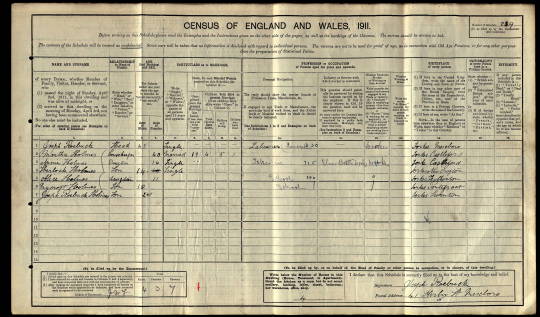
1911, his mother has split from his father, presumably, but not legally - given he is not on this census, tho she still listed herself married - but she has named her youngest son after her current employer (she is housekeeper to labourer Joseph Roebuck, and Joseph Roebuck Holmes is 2 years old), which is. Somewhat obvious, Mar, what were you doing?
Annie is now employed as a taker-in in a glass bottleworks, and is no longer listed as having "imperfect sight" - I wonder she got herself glasses?

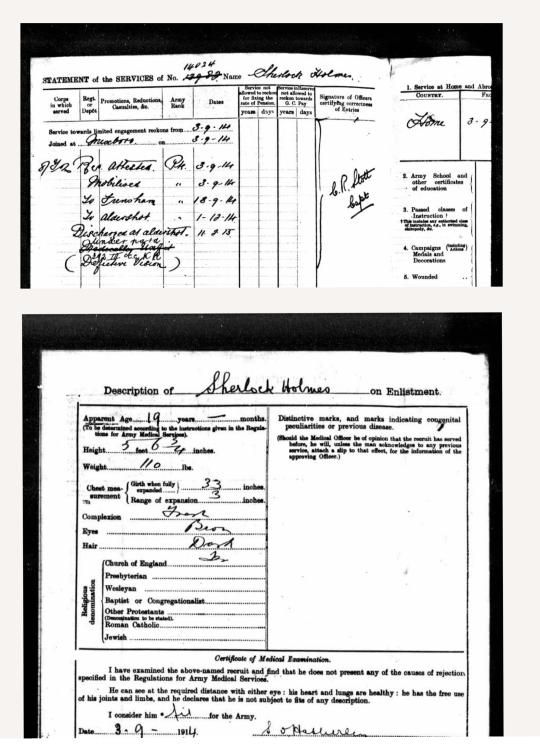
Next, 1914, he's called up for war - we see that he's a miner himself, like his dad, and he lasts for five months before he's discharged for "defective vision" - possibly due to working underground as he did, but given his sister, might also have been inherited. What is certainly inherited, one way or another, is his description - at age 19, he is 5 foot 6 3/4, fresh complexion, brown eyes and dark hair. He gives his father as next of kin, who is living at the same address as Martha was in 1911, so I should imagine they made up since then - one way or another. I checked out Richard in 1911, and it looks like he went back to live with his parents in Castleford, see below -
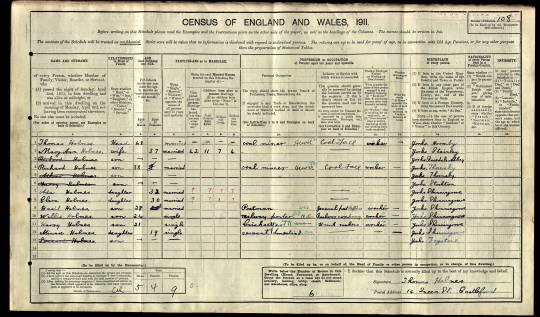
Then, back to Sherlock -

Here he is in 1939. There is no useful address given, and I'm not sure where his wife is living (Elizabeth Bratton, a former servant, married in 1919). He is a lance corporal, now - perhaps the Royal Engineers Fortress Section (whatever that might be) have less stringent requirements for vision than did the Yorkshire Reg in 1914, I've no idea.
There are six listings for Holmes's born to Bratton's between 1919 and 1939 - in order, Charles, Arthur, Irene, Annie, Stella and Joseph.

And, finally, his death in 1962.
If you're interested, Mycroft was born on boxing day 1900, a labourer who married a Janet White in 1929, and possibly had seven children - Martha and Joseph, certainly, and tho I have no real way to confirm Gordon, Joan, Brian, Harold and Beryl, there are spaces for them here - the 1939 register.

They close the record, usually, of those "under school age" or uh too young to not definitely be dead yet? That's the reason why they keep census records closed for 100 years after the fact, too, to be absolutely sure they're not giving out the records of people still alive - the 1921 census records only became available last year, but you still have to pay to read them last I checked.
Anyway, there you go, Sherlock Holmes.
At the time he was born, 13th March 1897, most recently The Memoirs of Sherlock Holmes had been published altogether, in 1894 - and that includes The Final Problem, where (fictional) Sherlock Holmes "died", which was in the Strand Magazine December 1893 - he wasn't revived until 1903, in "The Adventure of The Empty House"
I wonder what Martha and Richard thought of that fiasco?
Wonder if either of them wrote to ACD!
20 notes
·
View notes
Text
#OTD in 1921 – Francis Xavier Flood (one of the six and youngest IRA Volunteers charged for crimes of high treason and murder) is executed by hanging in Mountjoy Gaol.
Francis Xavier Flood, known as Frank, was a 1st Lieutenant in the Dublin Active Service Brigade during the Irish War of Independence. He was executed by the British authorities in Mountjoy Gaol and was one of the men commonly referred to as ‘The Forgotten Ten’. Flood was the son of a policeman and the 1911 census lists the family living at 15 Emmet Street. He was one of eight brothers, most of…

View On WordPress
#British soldiers#Dublin#England#Francis X Flood#Glasnevin Cemetery#History#History of Ireland#Ireland#Irish History#Irish War of Independence#Kevin Barry#Mountjoy Gaol#The Forgotten Ten
3 notes
·
View notes
Text
Louise Kirkby Lunn - O don fatale [Don Carlo] - 1911
Louise Kirkby Lunn (1873 – 1930) was a leading contralto who had trained in her native Manchester and studied at the Royal College of Music in 1890 for three years. In 1895 she appeared in the first of Henry Wood’s Promenade concerts and then began her stage appearances, including small roles at Covent Garden. Then in 1896 she joined the Carl Rosa Opera Company as principal mezzo-soprano until her marriage in 1899 to William Pearson. In the 1901 census they are living at Hyde Park Mansions, with a year old son named Louis Kirkby and her aunt Anne living with them. They later lived in St Johns Wood Park. She sang many roles at Covent Garden during the first two decades of the 20th century and first appeared at the Bechstein (later Wigmore) Hall in 1902, giving her first full recital (with pianist Percy Pitt) on 3 November 1906, followed by many others in subsequent years when her husband was manager there.
She also performed in a charity concert in aid of the Italian Hospital in London in July 1906 and was awarded the Gold Medal of the Royal Philharmonic Society for her rare combination of personal artistic achievement added to a richly endowed nature. She was famous for her Delilah in Samson and Delilah, and for Gluck’s Orfeo. In 1909, she sang Elgar’s Sea Pictures with Elgar conducting the orchestra. She often toured Europe and made trips to New York and Australia. In 1922 she made her farewell to Covent Garden with her celebrated part of Kundry but continued for some years to appear in concerts and recitals. Sir Henry Wood said she was a singer with a glorious voice and an even tone throughout a compass of well over two octaves, a singer with whom I never found fault in so much as a quaver all the years I worked with her, and who never sang out of tune.
#classical music#opera#music history#bel canto#composer#classical composer#aria#classical studies#chest voice#maestro#Louise Kirkby Lunn#O don fatale#Don Carlo#Giuseppe Verdi#contralto#dramatic mezzo-soprano#mezzo-soprano#coloratura contralto#Royal Opera House#Covent Garden#Metropolitan Opera#Met#Royal College of Music#Royal Choral Society#Royal Albert Hall#classical musician#classical musicians#classical history#history of music#historian of music
3 notes
·
View notes
Note
Hey Mr. Marwood, so I know you have an interest in all things swords and a bit of HEMA, so I thought you might like to see this game about sword dueling which is kind of realistic
https://youtu.be/APFeKwqcj-Y
This clip turned up a couple of days ago as part of a "you liked that, so you might like this" selection, and since then there have been a lot more clips, reactions etc.
The game reminds me - and others mention it - of “Bushido Blade” for the old Playstation that might still be in the attic, though “Hellish Quart” runs on Windows 7, and since I’ve just recently moved from W-8 to W-10 I don’t know if it would work on my machine even if I played games much these days (which I don’t.)
*****
NB, it’s not MARwood but MORwood (like on the username) despite a flub in the 1911 census which made tracking down that document more awkward than expected:

My Grandad didn’t fill this in himself, and the enumerator who did must have mis-heard and consequently mis-spelled the name. His handwriting differs from the 1901 census, which Grandad DID fill in and sign:

Grandad’s only contribution to the 1911 one was just a witnessed Mark.
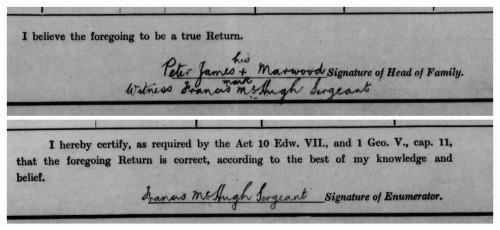
Even his job had changed. In 1901 he was a saddler and harness-maker (skilled work):
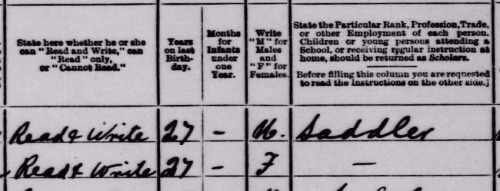
... while in 1911 he was a farm labourer (unskilled work):

My Mum told me he was a saddler (again) when she was a young woman between the wars, so this small dry piece of history may record a hand-injury of some sort that prevented him from practicing his trade until it healed.
At this end of time, I can only guess.
As for the Morwood / Marwood thing, it’s a family joke that predated the census error and hung around (cough) right through to my youth, all because of this character:
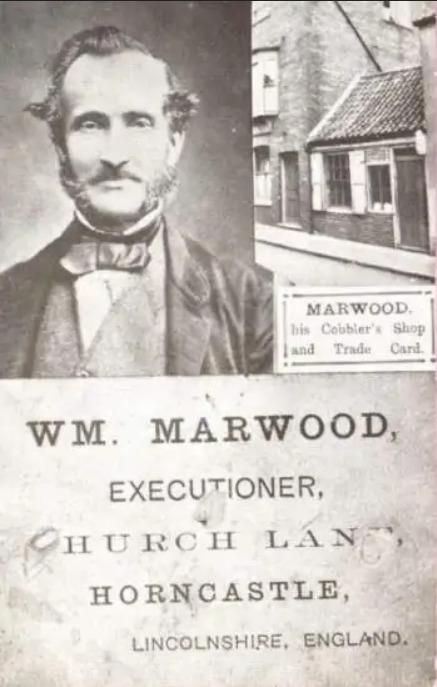
As the saying went, “If Pa killed Ma, who’d kill Pa? Marwood...”
I had an Uncle William - you can see him in the census - whose life at school must have been a lot of fun. I can imagine what it was like, because whenever I complained about having to wear a tie with my school uniform or anything else, I bet I was hearing the same comments...
:-P
22 notes
·
View notes
Text

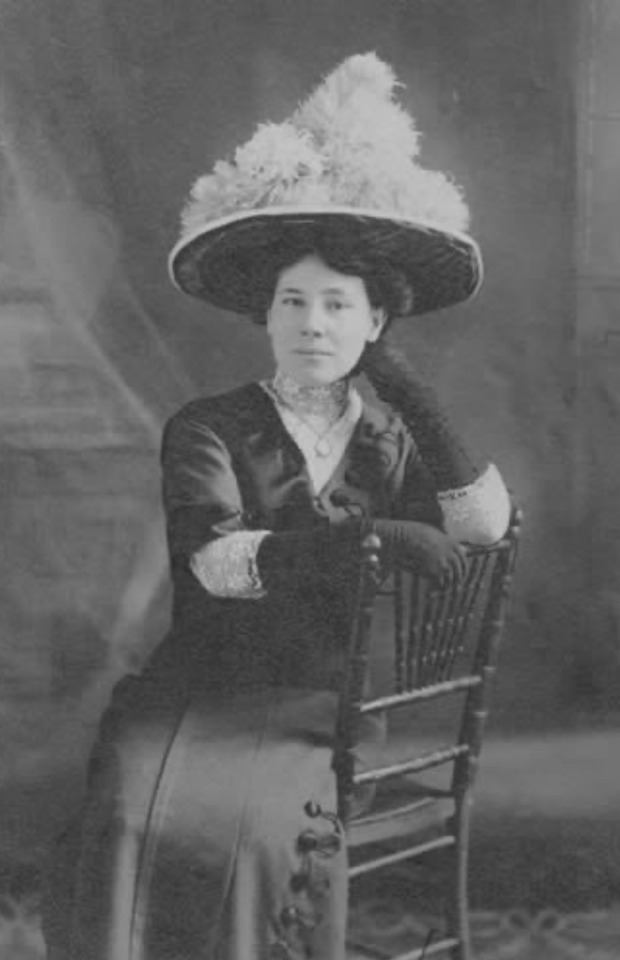
Marie Anne “Annie” Perreault, Titanic Survivor. Traveled with her employers, Mr. and Mrs. Charles M. Hays on board the Titanic.

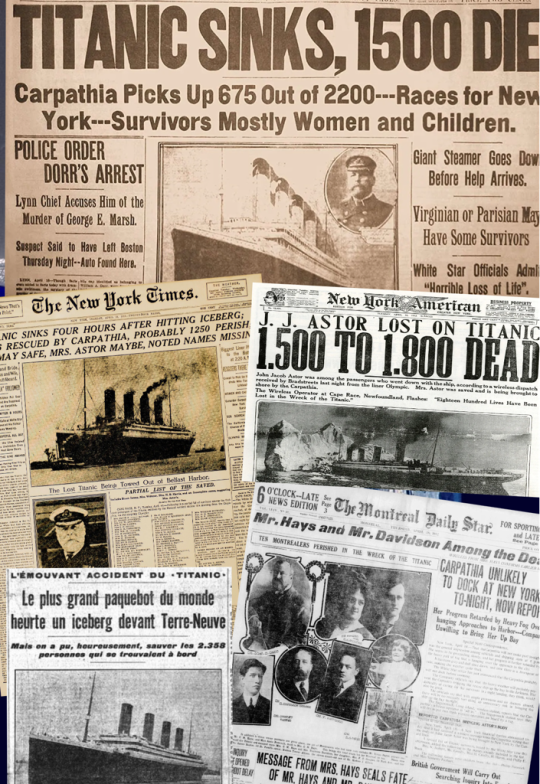
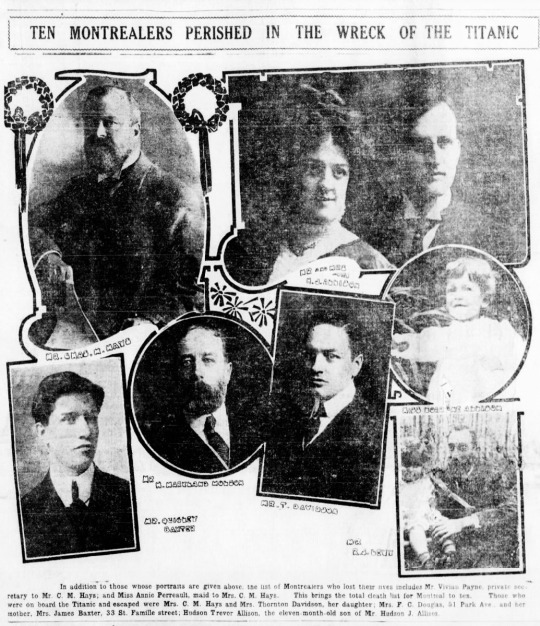
Montreal Daily Star, Thursday, April 15, 1911. Annie Perreault mentioned in the photo caption. Her employer, Mr. Charles M. Hays, is pictured in the top left corner.


The Toronto Star, 14 Apr 2012, Sat., Page 270, (Toronto, Ontario, Canada)
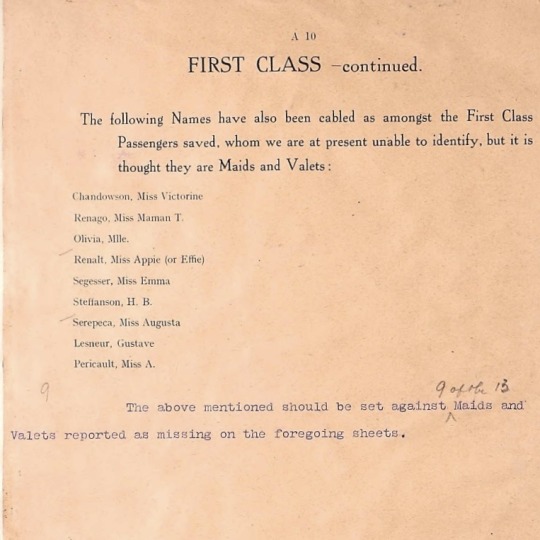
”First Class, continued: The following names have also been cabled as amongst the First Class Passengers saved, whom we are at present unable to identify, but it is thought they are Maids and Valets.” (Annie Perreault, is listed with a misspelling of her surname - “Pericault”)
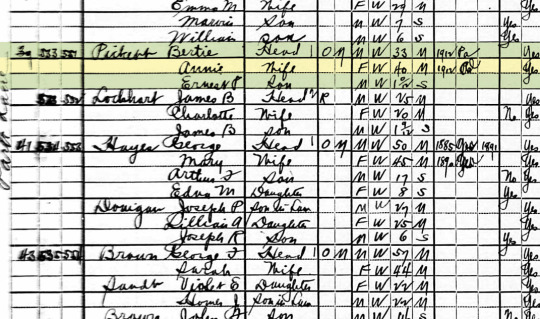
In 1912, Annie’s fiancé, Bert Pickett, arrived in New Jersey and they were wed in Trenton, NJ, on 9 December 1912. They are recorded as living in New Jersey in the 1920 U. S. Federal Census. (Above)
They moved to Rodeo, California around 1928 and opened a roadside business selling food and gasoline. Annie died in 1968.
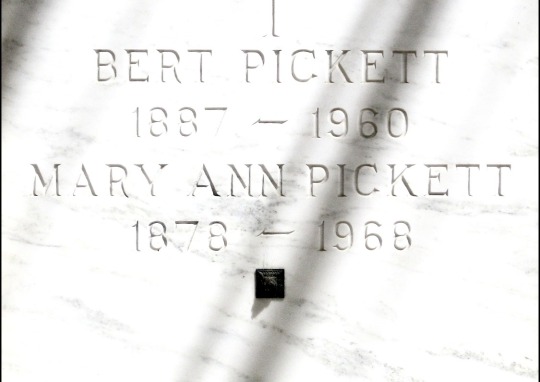
Obituary:
“Last rites were held today for Mrs. Mary Ann Pickett, 90, one of the survivors of the sinking of the Titanic on April 14, 1912. Mrs. Pickett, who died Monday, in Rodeo, Calif. had a clipping which listed her among the missing passengers when the big British liner went down after hitting an iceberg in the North Atlantic.”
More Information:
#perreault#the titanic#titanic#ocean liners#nautical#disaster#ships#shipping#history#nautical history#boats#survivor#shipwrecks#carpathia#unsinkable#family history#ancestry#genealogy#ancestors#cousin#french canadian#canadian history#english history#american history#family photos#iceberg#seafarers#cruise lines#cruise ship
3 notes
·
View notes
Text
Can’t believe Nova Scotia is simultaneously holding the titles of highest rate in Canada of uncircumcised dick and had a man in the Halifax census of 1911 legally named B J Needer. Leave some fucking space for the rest of us, why do they get all the fun stuff
2 notes
·
View notes